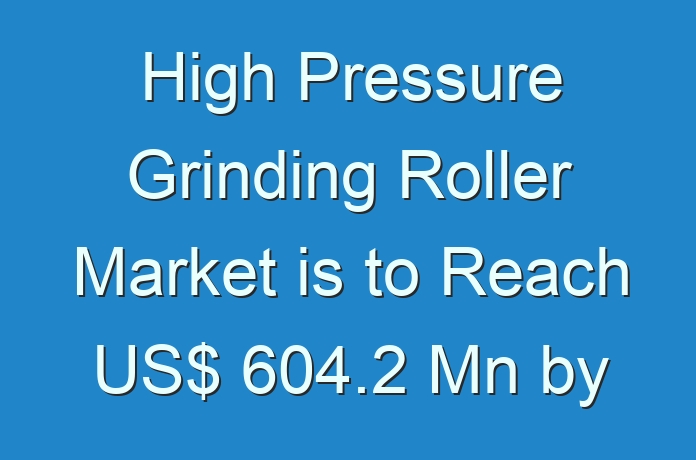
High Pressure Grinding Roller Market – Snapshot
High pressure grinding roller (HPGR) equipment is a modern energy-efficient comminution technology. The high pressure generates a substantial amount of fine material as it causes the boundary weakening in the feed material and formation of micro-cracks. High pressure grinding rollers are now commonplace in the briquetting, cement, diamond, and iron ore sectors. High pressure grinding rollers include two rolls mounted in a sturdy frame. One roll is allowed to float on rails and is positioned using pneumo-hydraulic springs, while the other is fixed in the frame. The feed is introduced to the gap between the rolls and is crushed by the mechanism of interparticle breakage. The world is rapidly becoming more green i.e. energy conscious. The mining industry is seeking ways to reduce its energy footprint since mining and mineral processing are massive energy users. In mineral processing and mining operations, energy is commonly the most high-budget cost item. Grinding, i.e. comminution, is generally the most energy-intensive step between metal and mine. One of the main reasons for using high pressure grinding rollers as a grinding alternative is due to its energy efficiency when compared to conventional crushers and mills. Relatively uniform and determinate loading of the material in the high pressure grinding roller compression zone is helping to improve its efficiency.
Want to know the obstructions to your company’s growth in future? Request a brochure @ https://www.transparencymarketresearch.com/sample/sample.php?flag=S&rep_id=3228
The global high pressure grinding roller market is expected to reach around US$ 604.2 Mn by 2026. The Asia Pacific high pressure grinding roller market incurred the highest share, accounting for US$ 101.6 Mn in 2017. The dynamics of the global high pressure grinding roller market are subject to factors mainly related to the increasing demand for high efficiency and low emission comminution solutions. Asia Pacific, Europe, and South America dominate the high pressure grinding roller market. Additionally, falling ore grades leading to demand for better comminution solutions worldwide has led to the growth of the high pressure grinding roller market. As a result of the ongoing exhaustion of high grade ore bodies, the average grade of ores is falling across the world. Thus, notwithstanding increased comminution activities, the value generated through obtaining the desired mineral after the mining process is reducing. This has caused the operating cost of comminution to rise. At the same time, the cost of commodities and minerals has not grown in the same proportion, thereby putting intense pressure on mining companies. Moreover, with decreasing proportion of the desired mineral in the mined ore, the output of the crushing and grinding process needs to be finer in order to help better extraction. This trend is being observed globally, and therefore the need to deploy high pressure grinding rollers for comminution processes across the world is also growing. In saturated markets such as Asia Pacific and Europe, technologically advanced equipment are mostly preferred for any job. Furthermore, with the introduction of wear abatement technology and significant design improvements, high pressure grinding rollers have undergone successful implementations and pilot demonstrations on extremely tough ores. Factors such as proven operational availability for some of the toughest and hardest ores and improved design have made high pressure grinding rollers attractive in the mining industry. Further, development of metal carbide studs and tiles specifically designed to produce an autogenous wear layer in the equipment are the other crucial factors increasing the use of HPGR in hard rock applications.
One of the major challenges affecting the growth of the high pressure grinding roller market is its high initial cost and higher maintenance needed. The higher initial capital cost of high pressure grinding rollers as compared to SAG and ball mills especially hampers the growth of small mining sites with low production, since the cost-saving benefits incurred through higher efficiency are often not sufficient to nullify the high investment required in high pressure grinding roller installation. Further, it has been reported that high pressure grinding rollers lead to increased material handling requirements. The use of high pressure grinding rollers also generates an increased quantity of dust. These factors act as a barrier to the growth of high pressure grinding roller market in the mining industry. However, it is expected that further technological advancements in high pressure grinding rollers and cost reduction due to the emergence of price-based competition would lead to an increase in demand for high pressure grinding rollers from small mining projects.
Looking for exclusive market insights from business experts? Request a Custom Report
Use of high pressure grinding rollers in hard rock mining is anticipated to create good growth opportunity for HPGR manufacturers. Till date, high pressure grinding roller technology has not been widely used in the treatment of hard rock due to challenges such as operational availability and wear rates. However, high pressure grinding rollers are becoming increasingly attractive for hard rock ore applications due to the steel media and escalating energy costs.
Some of the key players profiled in the global high pressure grinding roller market are CITIC Heavy Industries Co. Ltd., FLSmidth, KHD Humboldt Wedag International AG, Metso Oyj, Cast Steel Products, The Weir Group PLC, Thyssenkrupp, Koppern Group, Outotec, and TAKRAF GmbH.
Read Our Trending Press Release Below: https://www.prnewswire.com/news-releases/increased-internet-penetration-across-globe-driving-demand-opportunities-in-global-flexible-workspace-market-transparency-market-research-301169845.html





